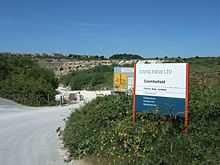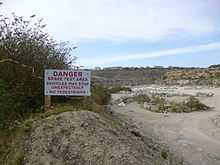Coombefield Quarry

Coombefield Quarry is an active stone quarry located on the Isle of Portland, Dorset, England. It is situated towards the north and east of the island's southernmost village Southwell, and south of Weston Street. The large quarry has been worked over many years, and has two voids in existence known as Coombefield North and Coombefield South. The quarry today incorporates the former Suckthumb Quarry, which is situated at the northwest part of the quarry, and is now filled in. The quarry is owned by Portland Stone Firms Ltd, along with Broadcroft and Perryfield Quarry. The firm is the largest landholder on the island.[1]
History

Coombefield Quarry was first quarried during the 1890s. Initially all Portland quarries were situated on the cliff-sides, and the new inland quarries of the late 19th to early 20th century began destroying many of Portland's ancient fields, particularly on the eastern side of the island. These supplied stone for the new facade of Regent Street in London, as well as an extension to the British Museum, to house the Elgin Marbles.[2] Planning consent for modern day quarrying on Portland was granted in 1951, covering 324 hectares of the island. Portland Stone Firms Ltd received and still holds the planning consent for Coombefield, Perryfield and Broadcroft. Coombefield Quarry has been open cast quarried over the last 80 years. It is largely of interest in having good sections of Portland Freestone from which large blocks are cut. The quarry has continued to expand through to the 21st century into neighbouring fields. A football field once existed within the area between the World Wars but this, as well as various footpaths and pasture land, would become quarried land.[3]
Today a small reserve is located at Coombefield South, while Coombefield North has ceased economic quarrying, and a stock remains alongside a fully automated weighbridge. Coombefield South also holds a stock of dimension stone blocks.[4] Coombefield is largely quarried for Coombefield Shelly Whitbed, Whitbed and XE. Shelly Whitbed is mostly a shelly stone, with an open texture, but does not have the openness of Roach. It has been noted for being exceptionally durable due to the high shell content.[5] The Whitbed stone is a tightly grained Portland stone with medium shell content, while the XE stone is a Whitbed, similar to Coombefield Whitbed,[6] but has a slightly more open texture and the occasional white fleck.[7]
Portland Stone Limited, another firm, operate out of four quarries on the island to extract stone to supply crushed materials. The stone is blasted, extracted, then crushed, screened, tested and loaded for transport. Aside from Coombfield, Broadcroft, Yeoland and Perryfield Quarries are also used for this purpose.[8]
Through quarrying a considerable number of Iron Age deneholes have been discovered on Portland, and notable locations include Coombefield, Kingbarrow and Broadcroft. These underground structures were cut into the ground, down to a maximum of 10 feet, and were entered by a vertical shaft. The island's early agricultural workers would store valuable corn grain within the chambers, and other discoveries include pottery and human bones. Although the creators of these chambers remain uncertain they are likely to be left by Iron Age settlers, who also created the island's first defences around 450 BC.[9]
In 2009 national news was made when a 135-million-year-old fossilised dinosaur footprint was stolen from the quarry. The print was chiselled out of a limestone slab, which had been unearthed by quarrying in 2002.[10]
The quarry is nearing the end of its working life and since circa 2006 owners Portland Stone Firms Ltd had looked at schemes for the soon-to-be disused area. In 2012 plans were unveiled for the quarry to be regenerated as a holiday caravan park to boost local tourism on the island. The multi-million pound holiday park and leisure complex is planned to accommodate up to 400 families. Including 250 static caravans, 110 holiday lodges and 35 camping pods, the plans also include leisure facilities, such as indoor and outdoor swimming pools, a cafe and a bar. These facilities are set to be open to locals. A BMX park, climbing centre, nature reserve and a new ground for Portland Town Football Club has also been proposed. The park has a number of planned environmentally friendly features. The development has been estimated to cost £3-5million, and would create 20 full-time and 120 seasonal jobs as well as giving a boost to local businesses and tourism.[11][12]
References
- ↑ "Portland Stone Quarries | Portland Stonefirms". Stonefirms.com. Retrieved 2013-03-02.
- ↑ Morris, Stuart (1985). Portland: An Illustrated History. Dovecote Press. p. 123. ISBN 978-0946159345.
- ↑ http://www.geoffkirby.co.uk/Portland/690705/
- ↑ http://www.stonefirms.com/portland-stone-range/portland-stone-quarry/
- ↑ http://www.stonefirms.com/portland-stone-range/coombefield-shelly-whitbed/
- ↑ http://www.stonefirms.com/portland-stone-range/coombefield-whitbed/
- ↑ http://www.stonefirms.com/portland-stone-range/coombefield-xe/
- ↑ http://www.portlandskips.co.uk/aggregate-services/our-quarries/
- ↑ Morris, Stuart (1985). Portland: An Illustrated History. Dovecote Press. p. 9, 10. ISBN 978-0946159345.
- ↑ http://news.bbc.co.uk/1/hi/england/dorset/7942365.stm
- ↑ http://www.dorsetecho.co.uk/news/9918260.Multi_million_pound_holiday_park_plans_unveiled_for_Portland/
- ↑ http://www.portlandbill.co.uk/coombefield/presentation_text.pdf
Coordinates: 50°32′02″N 2°26′18″W / 50.5340°N 2.4382°W
| ||||||||||||||||||||||||||||||||||||||||||||||||||||||||||||||||||